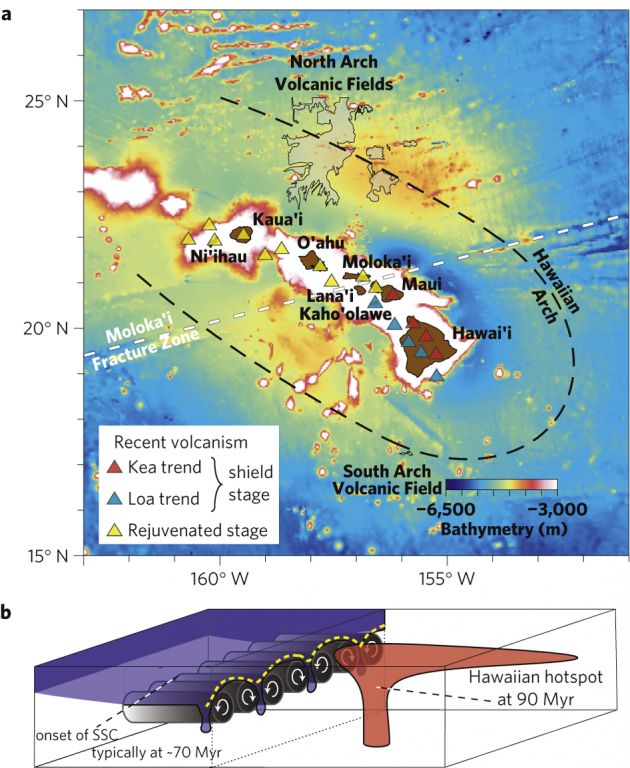博文
数值模拟研究夏威夷热点火山作用的成因
|||
数值模拟研究夏威夷热点火山作用的成因
Maxim D. Ballmer, Garrett Ito, Jeroen van Hunen and Paul J. Tackley
(周春银编译)
夏威夷热点火山作用(Hawaiian hotspot volcanism)一直都是地质学家研究的热点之一,也是经典板块构造理论(plate tectonics)和地幔柱(mantle plume)理论所重点讨论的地区。但是对于夏威夷地区(及周围地区)火山的成因,尤其是火山作用的物质来源,始终存在着一定的争议。前不久《Science》杂志文章根据地震层析成像研究,提出了与传统地球化学观点不一样的解释,认为夏威夷火山的物质来源可能并不是深部下地幔(见本博客文章《地幔转换带不连续面地震成像结果指示夏威夷西部存在热地幔》介绍)。近期,科学家通过数值模型提出了与传统地幔柱观点不同的机制来解释夏威夷热点火山作用的成因机制,文章《Spatial and temporal variability in Hawaiian hotspot volcanism induced by small-scale convection》发表在近期《Nature Geoscience》杂志上。
Nature Geoscience链接:http://www.nature.com/ngeo/journal/v4/n7/full/ngeo1187.html
补充材料:http://www.nature.com/ngeo/journal/v4/n7/extref/ngeo1187-s1.pdf
模拟movie:http://www.nature.com/ngeo/journal/v4/n7/extref/ngeo1187-s2.mpg
全文下载(PDF):2011-NG-Spatial and temporal variability in Hawaiian hotspot volcanism induced b.pdf
【原文摘要】远离板块边界的火山作用经常都被归因于下伏地幔柱作用。但是,目前有关夏威夷火山作用的一些观测,如火山喷发物质量随时间的变化、火山熔岩地球化学特征在地表的不对称性以及远离热点的次级火山作用,无法用经典地幔柱观点来解释。本文是对夏威夷地幔柱的数值模拟,发现地幔中的小规模对流可以侵蚀岩石圈的底部,从而在板块底部形成“搓衣板”(washboard)形的构造。当板块在地幔柱上升流之上移动时,地幔柱就会与厚度时而变化的岩石圈相互作用而随之产生火山喷发物质量的不断变化。原先的“搓衣板”构造也会引起地幔柱的不对称扩散和熔融。在该模拟中,这一地幔流的不对称性可以形成喷发熔岩地球化学特征的不对称性。最后,在地幔柱内会产生一种更加普遍的小规模对流作用,可以在远离热点的位置形成上升流的局部成带分布。相关的岩浆作用由起源于地幔柱管道边缘化学成分不同的物质提供物质来源。模拟结果显示浅部作用对深源地幔柱火山作用具有重要的影响。
经典的地幔柱通常都被描述为一个纯粹的由热驱动的、细小的上升流而穿越整个地幔最终在板块底部形成一个薄饼(pancake)构造。这样的上升流在动力学上可以形成一个拉长的抛物线形的海底地形隆起。相关的热点火山作用是定位和静止的,从而形成一条随时间递进的岛链。这一经典理论的确成功预测了热点链上的许多一级观测想象,夏威夷就是其中研究最多最著名的。

Figure 1. Overview and concept. a, Geographic overview and bathymetry of the Hawaiian Islands. Shield volcanoes are marked with triangles and arch volcanic fields with strong acoustic reflectivity are shaded. The shallow seafloor surrounding the islands is referred to as the Hawaiian arch (black dashed). b, Conceptual illustration of small-scale convection (SSC) interacting with the Hawaiian plume. Undulations on the base of the lithosphere (washboard pattern; dashed yellow line) were created by SSC in the ambient mantle.
有一系列的有关夏威夷火山作用的观测是无法用上述经典理论来解释的。首先,沿夏威夷-皇帝链的平均火山flux在一般~15 Myr尺度内变化大于2倍之多。其次,火山熔岩地球化学特征的不对称性目前还不清楚。最后,广泛发育的远离夏威夷热点的次级火山作用目前仍难于解释成因(Fig.1a)。本研究模拟表明,岩石圈下小规模对流(small-scale sublithospheric convection, SSC)和夏威夷地幔柱的相互作用(Fig.1b)可以解释以上这些观测到许多重要方面。本模拟与前任动力学模拟研究的不同点在于,本模拟考虑了更大的尺度以及与温度紧密相关的地幔流变学性质,并同时模拟了地幔柱薄饼构造内外的SSC作用。详细的模拟条件和方法见原文p458第二段和补充材料。

Figure 2. Visualization of the central part of the reference model. a, Horizontal (at 130 km depth) and vertical cross-sections are coloured by potential temperature Tpot. The hotspot and secondary melting zones are in black. Isotherms of 1,550 and 1,620 ºC are white. Black arrows show the direction and strength of ambient-mantle SSC 800 km upstream of the plume. See also Supplementary Movie. b, Vertical cross-section of Tpot and viscosity η through the upwelling plume oriented perpendicular to plate-motion with contours denoting log10(η). Upper panel shows a blow-up of the yellow-shaded area. Light blue arrows show the schematic flow field indicating that the plume pancake spreads asymmetrically as guided by undulations in lithospheric thickness.
模拟结果预测了两种类型的SSC发育(Fig.2a)。一种是在通常地幔中,SSC自组织于成熟的大洋岩石圈下面,可以控制大洋岩石圈的最大厚度和海底年龄降低。另外一种SSC发育在岩石圈下面地幔柱薄饼(mantle-pancake)构造内,更加普遍。前一种SSC可以在岩石圈底部形成“搓衣板”构造,岩石圈在上升流之上较薄而在下降流之上较厚(Fig.2b)。

Figure 3. Source and volume flux of surface volcanism. a, Colours give the pyroxenite contribution to volcanism (grey is no volcanism), and contours denote the rate of volcanism per area of seafloor. From outside to inside, dashed contours are at 0.01, 0.1, 1, and 10 km3 km-2 Myr-1. The solid contours follow the same log scale shifted by 100.5. Pyroxenite contribution XPX in the centre of the hotspot is ~50%, but is slightly higher and lower along the Kea and Loa trends, respectively. This distinction persists through the postshield stage, as does the geochemical distinction between the two trends. Rejuvenated and arch volcanism shows relatively low (~40%) and high (>97%, not shown) XPX, respectively. b, Dashed lines denote volcanic fluxes (km3 Myr-1 per km of distance along the chain) for the Kea trend (red), the Loa trend (blue), and the total of both trends (black). The assumed feeding zones for the two trends are denoted light grey in a. Solid lines show the pyroxenite contribution for the same colour code, and elucidate the asymmetry of shield and postshield volcanism arising from the distribution shown in the map view in a. The bold black number indicates the total flux of hotspot volcanism in (km3 Myr-1). Green and grey shadings denote the predicted durations of the major phases of Hawaiian volcanism (as defined by volume flux).
在模拟中,温度不同的Kea端和Loa端内熔融行为的差异(辉石岩源熔体比例XPX不同),是由SSC和地幔柱相互作用以及小规模成分不均一性造成的(Fig.3)。而地幔中SSC的形态和强度对于夏威夷火山物质量也具有重要影响(Fig.3b),地幔柱与厚度不同的岩石圈相互作用能够引起火山物质量的变化,而这并不是深部地幔作用的产物。远离热点中心的地幔柱-薄饼构造中的SSC可以引起减压熔融,从而也可以解释广泛发育的次级火山作用的成因(Fig.3a)。
更多详细内容请参考原文。
https://blog.sciencenet.cn/blog-92454-463303.html
上一篇:德国麻粒岩中发现金刚石和柯石英
下一篇:下地幔中Fe的价态和分配(JGR最新文章)